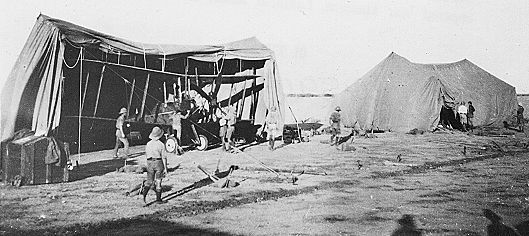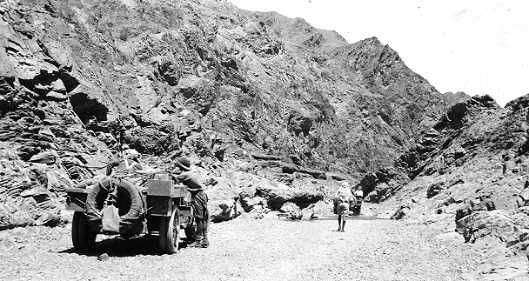
LAWRENCE'S AIR FORCE |
| < back to Hejaz Page ... < previous | 1 | 2 | 3 | 4 | 5 | 6 | 7 | 8 | 9 | 10 | 11 | 12 | 13 | next > |
| The RFC portable tent hangars at Rabegh, their first base in the Hejaz. The mechanics had to work in these conditions throughout the nine months the detachment was in Arabia. |

|
|
As well as the necessary Air Mechanics and Fitters, the party included Royal Army Medical Corps and Army Service Corps personnel. The initial complement of officers was:
500 men of the Egyptian Army were also present, so manhandling stores, building a rough road and suchlike jobs were no problem. Eventually, four machines were erected and from 28 November, daily local reconnaissance flights were undertaken. The maps supplied were practically useless, so these flights were essential to create a set of useful hand-drawn maps and sketches upon which they could rely. On 8 December 1916, a reconnaissance was flown from an advance landing ground at Yenbo, in the direction of Bir Said, to check on Turkish troops moving south in that region. Yenbo on the coast 120 miles north of Rabegh, was the HQ of Emir Feisal and his Northern Army. Earlier on 21 October, Capt Lawrence had left Rabegh by camel accompanied by a guide, to a meeting with Feisal at Bir Abbas, a journey of over 100 miles. |
Lawrence had to be seen as a pale-faced Syrian deserter from the Ottoman Army, a pretence to cover his mission should he be met by others. To this guise was added an Arab headdress, his very beginning of this practice. Lawrence was with Feisal at this time and requested reconnaissance flights be made to keep an eye on the enemy's movements. The winter rains had arrived and for some days the aerodrome ground was too soft to operate the machines. It was not until 6 January 1917 that an offensive mission could be flown against an enemy camp at El Hajah. Major Ross in 4478, Lt Floyer in 4483 and Capt Henderson in 4488 dropped a total of 24 Hales bombs, but the results were not encouraging as a number of them failed to explode. This raid was followed some days later on the 25th by another and more effective one on a Turkish camp at El Ghayir; Henderson in 4488 and Capt F.H. Bevan in 5421. The enemy withdrew his men from the camp, so success to the RFC. March came, and the improved weather brought an increased number of reconnaissance flights. Practice at picking up messages (hooking) from the ground proved that this was a practical idea, except that some attempts were unsuccessful. Major Ross collected his message but then had the wire entangled in his elevator while Lt Henderson lost his aerial in the process. The unit's War Diary calls it 'Despatch-lifting'. Further personnel had now joined 'C' Flight Detachment. 2Lt J.M. Batting and V.D. Siddons were pilots while Lt R.H. Brewis, J.A.B. Lane and 2Lt J.H. Loveridge were observers. On 5 March, two machines flew a longer reconnaissance to Medina, landing at a forward ground at Mijz, to refill their tanks, before flying on to their target. The Turkish camp was east of the railway station while northwest of the town was an aerodrome with four large hangars. |
|||||||||||||||||||||||||||||||||||||||
| An impressive view of the rugged terrain in the Arabian hinterland, with Rolls Royce and Crossley tenders negotiating the trackless route. |

|